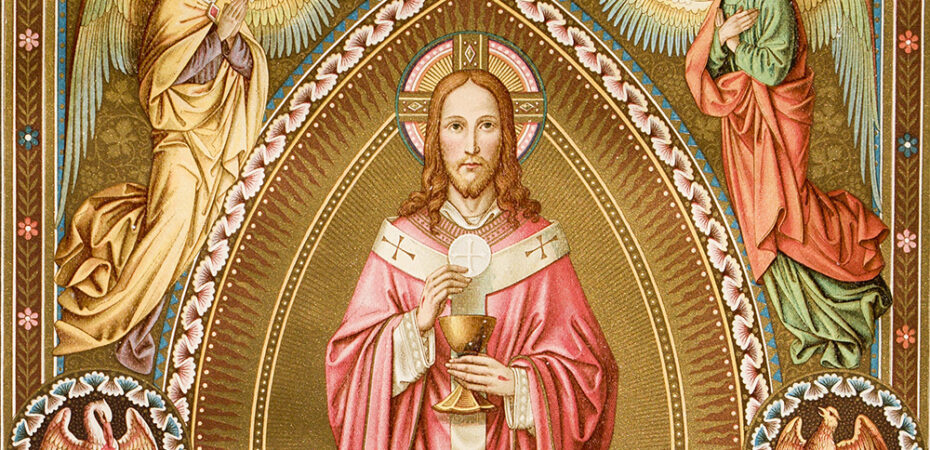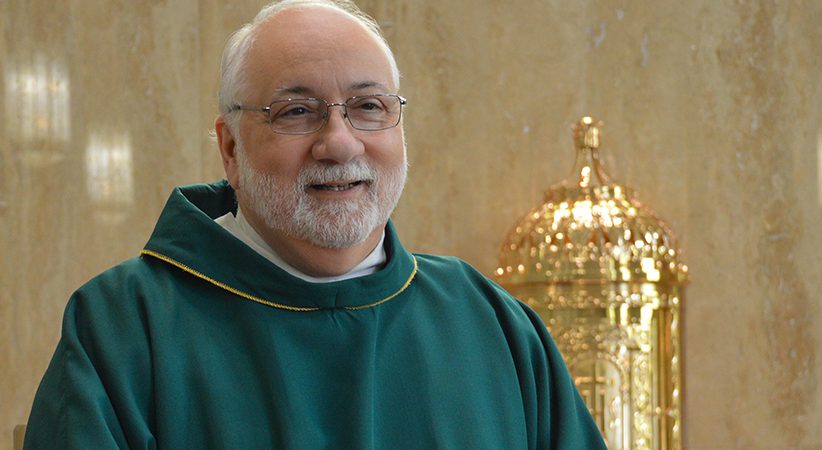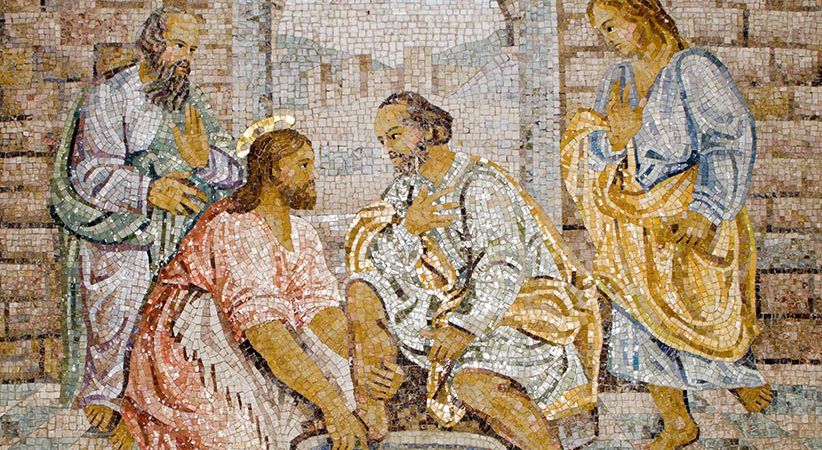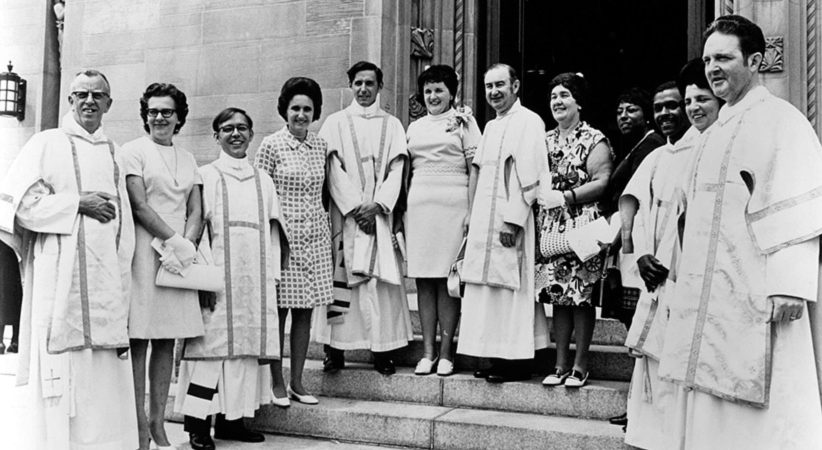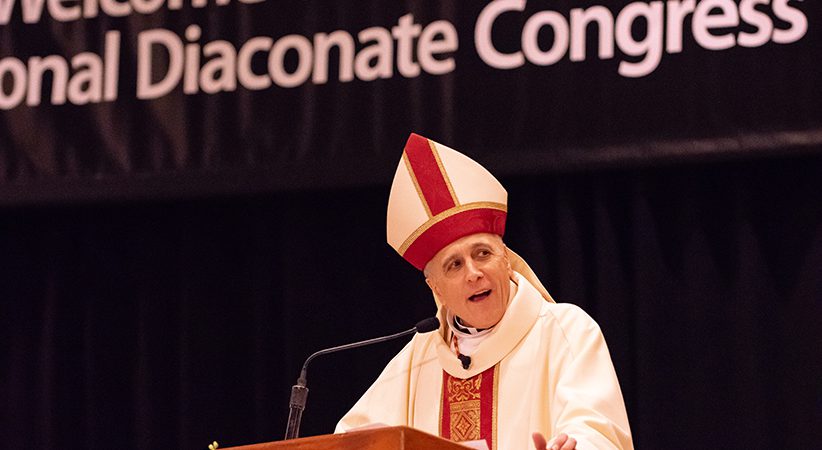Fulfilling Our Role in the Eucharistic Awakening
How a deacon can support the Eucharistic Revival
Deacon Victor Puscas Comments Off on Fulfilling Our Role in the Eucharistic Awakening
In November 2021 the U.S. Conference of Catholic Bishops met in Baltimore for its Fall General Assembly. There the bishops unveiled a three-year Eucharistic Revival that will culminate with the National Eucharistic Congress in 2024 in Indianapolis. Bishop Andrew Cozzens of the Diocese of Crookston, Minnesota, gave the bishops the details about this planned revival.
Bishop Cozzens, chairman of the USCCB’s Committee on Evangelization and Catechesis, said the revival could be a time of healing for the entire Church as well as a movement of evangelization and reawakening of understanding the Sacrament of the Eucharist for Catholics across the country.
Why do we need this revival? Because, among other reasons, a recent Pew Research Center survey reported that just one-third of U.S. Catholics agree with the Church that the Eucharist is the body and blood of Christ. Transubstantiation, the survey explains, is the idea that during Mass, the bread and wine used for Communion becomes the body and blood of Jesus Christ and it is central to the Catholic Faith. According to the Catechism of the Catholic Church, the Eucharist is “the source and summit of the Christian life” (No. 1324) and Christian spirituality flows from the Eucharist (the source). Therefore, Christian actions should be directed toward it (the summit).
But the 2019 Pew survey found that most self-described Catholics did not believe this core teaching. In fact, nearly 7 in 10 Catholics (69%) say they personally believe that during Catholic Mass the bread and wine used in Communion “are symbols of the body and blood of Jesus Christ.” Clearly, our work is cut out for us.
Revival Plans
So what exactly is the National Eucharistic Revival, and how can deacons support it? The revival will officially start on the feast of Corpus Christi, June 16, 2022. The first year of the revival will be called the “Diocesan Year” with a diocesan focus that will include Eucharistic processions and other events of adoration and prayer around the country.
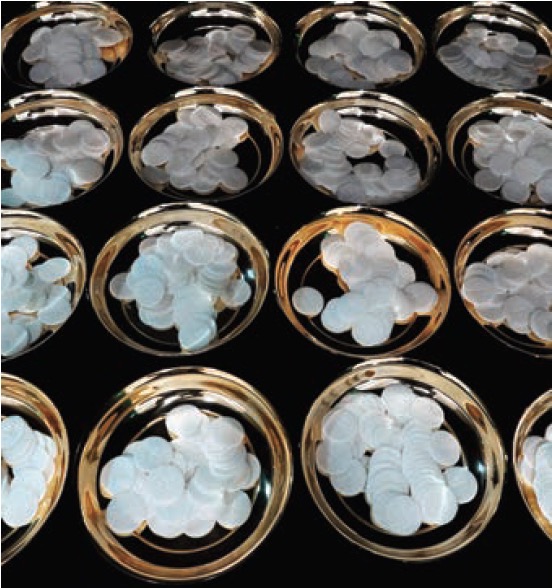
Blessed Carlo Acutis will be the patron for the first year of the revival. Acutis is an Italian teen who was beatified in October 2020. He died of leukemia in 2006 at age 15, but he had a special devotion to the Blessed Sacrament. He was a computer programmer who used social media to unite many people and spread Christian values.
The second year, beginning in 2023 will be called the “Parish Year” with an emphasis on parishes and resources aimed at increasing Catholic’s understanding of what the Eucharist really means.
The second year will culminate with a Eucharistic Congress held in the Archdiocese of Indianapolis July 17-21, 2024. This plan envisions a national pilgrimage with both in-person and virtual dimensions, aiming to form and send forth more than 80,000 Eucharistic missionaries.
The third year, the Missionary Year, and all subsequent years, will focus on ongoing revival. This large-scale Church event, Bishop Cozzens pointed out, can be transformative and may be revisited 10 years from now.
…………………………………………………………………………………………………………………………………………………………………
Resources
The featured resources for the Eucharistic Revival are as follows:
2022
Winter: Launch of EucharisticRevival.com website
Spring: Toolkit and training resource for diocesan Corpus Christi processions
Summer: Turnkey recommendations for Eucharistic events and formation opportunities
Fall: National Eucharistic preachers sent to diocesan events; catechetical resources on the liturgy
2023
Winter: Social media campaign for Lenten devotions
Spring: Toolkit and training resources for parish Corpus Christi processions
Summer: Training materials and resources for parish small group formation
Fall: McGrath Institute’s online training for Eucharistic witnesses; prayer cards on “how to live a Eucharistic day.”
2024
Winter: Our Sunday Visitor tract on Eucharistic belief and practice
Spring: Pilgrimage of regional processions to the National Eucharistic Congress
Summer: National Eucharistic Congress and missionary sending
Fall: Resources for Eucharistic missionaries
………………………………………………………………………………………………………………………………………………………………….
Greatest Treasure
Bishop Kevin C. Rhoades, chairman of the USCCB’s Committee on Doctrine and bishop of the Diocese of Fort Wayne-South Bend, said that the Eucharist is the greatest treasure of the Church. It is the gift of God himself to his people. It is a gift of love that “makes the Church,” because Christ unites us to himself and to each other.
What do we do with this gift? We go out on mission. We respond in faith, we give thanks, we actively participate with reverence and adoration. The Eucharist is a mystery to be lived — to imitate the self-giving love of Jesus. We receive Jesus who then sends us on a mission in which we give Jesus away to others. It is to be a deacon!
Five Pillars
The mission of the National Eucharistic Revival is, “To renew the Church by enkindling a living relationship with the Lord Jesus Christ in the Holy Eucharist.” The vision of the revival is, “A movement of Catholics across the United States, healed, converted, formed and unified by an encounter with Jesus in the Eucharist — and sent out in mission ‘for the life of the world.’” The mission and vision will be accomplished through five strategic pillars:
- Foster encounters with Jesus through kerygmatic proclamation and experiences of Eucharistic devotion.
- Contemplate and proclaim the doctrine of the Real Presence of Jesus in the Eucharist through the truth of our teaching, the beauty of our worship and the goodness of our accompaniment of persons in poverty and those who are vulnerable.
- Empower grassroots creativity by partnering with movements, apostolates, parishes and educational institutions.
- Reach the smallest unit: parish small groups and families.
- Embrace and learn from the various rich intercultural Eucharistic traditions.
Diaconal Support
How can deacons support the Eucharistic Revival? Well, it seems to me that deacons are uniquely qualified to lead Eucharistic devotions, to make their lives an offering to the Church, and then to go out on mission for the life of the Church.
The new National Directory reminds us that the “deacon leads the community to reflect on its communion and mission in Jesus Christ, especially impelling the community of believers to live lives of service.” Further, “the deacon is ordained precisely for service in both the sanctuary and the marketplace.”
As we revisit the strategic pillars, there are five ways a deacon can support the Eucharistic Revival.
First, the deacon can absolutely foster encounters with Jesus through kerygmatic proclamation and experiences of Eucharistic devotion. Kerygma is, of course, the apostolic proclamation of salvation through Jesus Christ. Deacons preach that through their everyday experiences in their sacred and secular lives.
……………………………………………………………………………………………………………………………………………………………
The Cry of the Poor
“Saint Teresa of Calcutta is an outstanding example in more recent times of someone who learned to recognize Christ in the poor. It was her deep faith in the Eucharist and her reception of holy Communion that motivated her loving care of the poorest of the poor and commitment to the sanctity of all human life. In beholding the face of Christ in the Eucharist, she learned to recognize his face in the poor and suffering. Mother Teresa is said to have asserted: ‘We must pray to Jesus to give us that tenderness of the Eucharist. Unless we believe and see Jesus in the appearance of bread on the altar, we will not be able to see him in the distressing disguise of the poor.’”
— “The Mystery of the Eucharist in the Life of the Church,” U.S. Conference of Catholic Bishops, No. 37.
……………………………………………………………………………………………………………………………………………………………
Moreover, deacons are oftentimes the principal celebrant in Eucharistic adoration, Benediction and reposition. Deacons participate in Forty Hours devotion and Eucharistic processions, often leading the processions with the monstrance. These experiences of Eucharistic devotion are powerful witnesses to the importance of the Eucharist to the community.
Second, through his ministry of word, liturgy and charity, the deacon assists the Church by teaching, sanctifying and leading. The deacon is privileged to proclaim the doctrine of the Real Presence of Jesus in the Eucharist through the truth of the teaching of the Church. Deacons are often in the position of presenting the catechesis of the Church. We have to know something about God before we can evangelize.
Deacons add to the beauty of worship by full, conscious and active participation in the liturgical celebration and reverent, purposeful assistance to the priest. In so doing, the deacon should always be mindful of the vulnerable and the Church’s preferential option for the poor. In his address to deacons, Pope Francis recently said that “deacons are dedicated to the service of the poor, who carry within them the face of the suffering Christ.”
Third, deacons are often involved in national or diocesan movements or apostolates such as Cursillo, the Knights of Columbus, Catholic Alpha and many other organizations. By partnering with these movements, and engaging in grassroots creativity, deacons can empower these apostolates to renew the Church. St. Ignatius of Loyola was convinced that God can speak to us as surely through our imagination as through our thoughts and memories.
In the Ignatian tradition, praying with the imagination, or thoughtful grassroots creativity, is called contemplation. Contemplation is a very active way of praying that engages the mind and heart and stirs up creativity. Leading contemplative prayer, particularly in front of the Blessed Sacrament, can be yet another way deacons can support the Eucharistic Revival.
Fourth, the deacon is uniquely positioned to reach the smallest units of a parish through his understanding of and participation in small groups and families. This attends to the Catholic social teaching concept of “subsidiarity.” Subsidiarity is an organizing principle that suggests that matters ought to be handled by the smallest, lowest or least centralized competent authority.
By involving himself in these small parish groups, not the least of which is his own family, the deacon furthers the strategic goals of the Eucharistic Revival by witnessing to the intersection of the sacred and the secular.
Finally, the deacon can embrace and learn from the various rich intercultural Eucharistic traditions. Liturgically, in addition to the Mass, deacons are privileged to participate in many multicultural Eucharistic traditions extraordinarily important for evangelization.
For example, the Vietnamese Eucharistic Youth Movement (VEYM) is a nonprofit faith-based organization that aims to train youths to become well-rounded individuals within society and ideal Christians. The VEYM is a branch of the Apostleship of Prayer, now known as the Pope’s Worldwide Prayer Network, an official pontifical service under the Holy See. However, it is likely that this movement has not yet entered into the Catholic imagination. As the deacon participates in support of these movements, he helps to move the Church from maintenance to mission.
Bishop Cozzens said, “This is a once-in-a-generation opportunity to impact the faith life of this country.” He continued, “This is a movement of Catholics across the United States, healed, converted, formed and unified by an encounter with Jesus in the Eucharist — and sent out on mission for the life of the world.” This speaks to the very nature of what a deacon is — the Church’s service sacramentalized — nourished and sent.
Remembrance
According to Pope Benedict XVI: “The remembrance of his perfect gift consists not in the mere repetition of the Last Supper, but in the Eucharist itself, that is, in the radical newness of Christian worship. In this way, Jesus left us the task of entering into his ‘hour.’ ‘The Eucharist draws us into Jesus’ act of self-oblation. More than just statically receiving the incarnate Logos, we enter into the very dynamic of his self-giving’” (Sacramentum Caritatis, No. 11).
But any Catholic can give the gift of self. The question for us today is, How can the deacon give himself to the Eucharistic Revival in a way that is unique?
The answer may come from Deacon James Keating’s book, “The Heart of the Diaconate” (Paulist Press, $12.95). He writes: “The Prayer of Consecration makes it plain that the Church is not looking for another group of active men — men who do good works; the Church has those in many quarters. Instead, the Church is looking for a group of spiritual leaders — men who live from the inside out, regularly offering their hearts to Christ as places for him to come into and live his mysteries. The deacon must learn to endure this coming of Christ lovingly and, after doing so, witness to the effect that such an interior life has on the larger life of church and society.”
In other words, the deacon is fed by the Eucharist, by which he is conformed to Christ the Servant. Then he is able to go out into the marketplace infused with an authentic and lively interior life to bring Jesus’ heart to others. In so doing, he necessarily draws people back to the Church in a never-ending dynamic of self-giving.
The USCCB summarizes the goal of the Eucharistic Revival by repeating words attributed to St. Teresa of Calcutta: “Once you understand the Eucharist, you can never leave the Church. Not because the Church won’t let you, but because your heart won’t let you.”
DEACON VICTOR PUSCAS is director of diaconate formation for the Diocese of Joliet, Illinois. He holds a D.Min. degree from Catholic Theological Union in Chicago.
………………………………………………………………………………………………………………………………………………………………
Being Transformed in Christ
We read in “The Mystery of the Eucharist in the Life of the Church”: “The personal and moral transformation that is sustained by the Eucharist reaches out to every sphere of human life. The love of Christ can permeate all of our relationships: with our families, our friends, and our neighbors. It can also reshape the life of our society as a whole. Our relationship with Christ is not restricted to the private sphere; it is not for ourselves alone. The very solidarity or communion in Christ’s self-giving love that makes the Church and makes us members of the Church orders us beyond the visible community of faith to all human beings whom we are to love with that very same love that forms our communion with the Lord. Otherwise, if we do not love all human beings in this way, our communion with the Lord is impaired or even contradicted. This love extends particularly and ‘preferentially’ to the poor and the most vulnerable. We all need to be consistent in bringing the love of Christ not only to our personal lives, but also to every dimension of our public lives” (No. 35).
……………………………………………………………………………………………………………………………………………………………….

